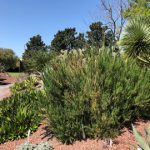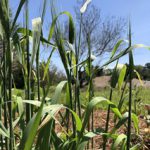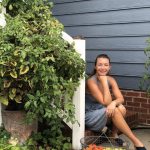 Written by: Kelly Thomas – Agricultural/Food Scientist II with the University of Florida/IFAS North Florida Research and Education Center
Written by: Kelly Thomas – Agricultural/Food Scientist II with the University of Florida/IFAS North Florida Research and Education Center
Imagine walking out your front door with a cup of coffee to admire your garden. A cucumber vine, ripe with crisp, succulent fruit, has grown so large and sprawling that the white staircase handrail is serving as its trellis. The resulting appearance is a lush green entranceway to the front door. The wall of cucumber leaves stands tall behind burgundy-colored day lilies and stokes asters that are shockingly blue. Nearby, buzzing bees feed on fragrant basil flowers. The plum tree planted near the road is heavy with perfectly round reddish-purple fruit that is almost ready to harvest.

Foxtail rosemary (Rosmarinus officinalis) standing tall in the Dry Garden. Photo Credit: Kelly Thomas – University of Florida/IFAS
You’ve taken up foodscaping, the concept of integrating ornamental plants and edible plants within a traditional landscape. It began during the pandemic with more time spent at home, and the desire to tend to the growth of something. Now, the garden’s bounty has provided groceries, which has proven doubly beneficial as the pandemic continues to disrupt the supply chain and drive up the cost of food.
The concept of foodscaping is not new. In fact, foodscaping has been around in some form or fashion for centuries. In the early 2000’s, Sydney Park Brown, now a UF/IFAS emeritus associate professor, published an EDIS document titled ‘Edible Landscaping.’ Brown describes how edible landscaping allows people to create a multi-functional landscape that increases food security, reduces food costs, and provides fun and exercise for the family, along with other benefits. Foodscaping, another term for edible landscaping, really took off as a movement during the 2008 economic recession.
Around that time, a horticulturist named Brie Arthur wanted to grow vegetables to save money on groceries. However, the restrictions placed by her H.O.A. forced her to venture away from a standard vegetable garden. Within six months, Arthur had won ‘Yard of the Year,’ proving that edible plants can also be aesthetically pleasing, especially when incorporated into a landscape design. Now, her one-acre lot in North Carolina provides almost 70% of what she and her husband consume. Her garden produces food year-round, everything from sweet potatoes, garlic, and pumpkins to edible flowers like dahlias. She even grows sesame and barley, or as she calls it, “future-beer.”

Utrecht blue wheat beginning to form seed heads. Photo Credit: Kelly Thomas – University of Florida/IFAS
Brie Arthur is a charismatic speaker and bestselling author. She continues to be a major proponent of the foodscape movement, inspiring others to realize their landscape’s full potential. Arthur came and gave an energetic and action-packed presentation on foodscaping at UF/IFAS North Florida Research and Education Center (NFREC) in Quincy, FL on March 5th, 2022. Before the workshop, which was titled ‘A New Era in Foodscaping’ adjourned, participants toured edible displays in Gardens of the Big Bend (GBB), a botanical garden located at the UF/IFAS NFREC. Tour participants walked by golden and red-colored amaranth plants bordered by carrots in the Discovery Garden. Waist-high rosemary plants held their own next to agaves and other desert giants in the Dry Garden.
For more information and advice on foodscaping, check out Brie’s YouTube channel, Brie the Plant Lady. Photos of her garden in North Carolina can be found on her blog. University of Florida resources on edible landscaping/foodscaping can be found via EDIS. And come visit Gardens of the Big Bend in Quincy to view edible garden displays in person!
- Foodscaping – Create Beauty and Bounty - April 7, 2022
- Cold-hardy Bromeliads for North Florida - December 15, 2021
- How to Hunt for “New” Plants - September 2, 2021

